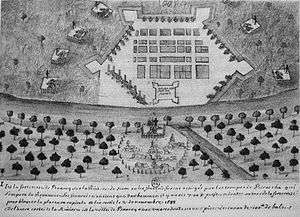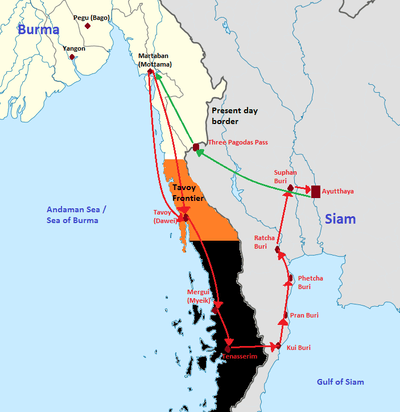List of wars involving Thailand
This is a list of wars involving the Kingdom of Thailand, its predecessor states, and by Siamese people, from antiquity to the present day. It also includes wars fought outside Thailand by Thailand military.
Ayutthaya Kingdom
| Conflict | Combatant 1 | Combatant 2 | Results |
|---|---|---|---|
| Ayutthaya–Lan Na War (1441–1474)[1] Location: Northern Ayutthaya, Southern Lan Na[2] 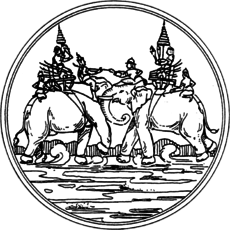 War elephants depicted from a later Siam–Burma war. |
Kingdom of Lanna[1][3] | Stalemate[3] | |
| First Siege of Ayutthaya (1547–1549) Location: Upper Tenessarim coast, western and central Siam  Painting by Prince Narisara Nuvadtivongs, depicting Queen Suriyothai (center) on her elephant putting herself between King Maha Chakkraphat (right) and the Viceroy of Prome (left). |
Toungoo Dynasty | Siamese defensive victory
| |
| Second Siege of Ayutthaya "War over the White Elephants" (1563–64) Location:Ayutthaya, Phitsanulok, Sukhothai |
Toungoo Dynasty Vassal Lan Na Vassal Sukhothai |
Burmese victory
| |
| Third Siege of Ayutthaya (1568–70) Location:Ayutthaya, Phitsanulok, Kamphaeng Phet and Lan Xang |
Kingdom of Lan Xang |
Toungoo Dynasty Vassal Sukhothai |
Burmese victory
|
| Fourth Siege of Ayutthaya "Naresuan the Great campaigns to free Ayutthaya" (1584–1593) Location: Ayutthaya Kingdom and lower Tanintharyi Region 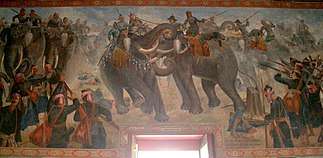 Elephant battle between Naresuan and Mingyi Swa during the Battle of Nong Sarai as wall murals in Phra Ubosot, Wat Suwan Dararam, Ayutthaya, Thailand. |
Toungoo Dynasty | Siamese victory
| |
| Siamese–Cambodian war (1591–1594) Location: Cambodia |
Siamese victory
| ||
| First Siamese invasions of Burma (March 1594 –November 1605) Location: Southern and central Burma .jpg) King Naresuan entered Pegu, mural painting by Phraya Anusatchitrakon, Wat Suwandararam, Ayutthaya. |
Toungoo Dynasty | Siamese victory
| |
| Burmese–Siamese war (1613–14) Location: upper Tenasserim coast and Lan Na |
Toungoo Dynasty | Burmese victory | |
| Second Siamese invasions of Burma (1662–1664) Location: Northern Siam and Tenasserim coast |
Toungoo Dynasty | Burmese defensive victory
| |
| Burmese–Siamese war (1675–76) Location: Tenasserim coast |
Toungoo Dynasty | Burmese and Siamese defensive victory
| |
| Anglo-Siamese War (1687–1688) Location: Mergui and Coromandel coast |
Inconclusive
| ||
| Siege of Bangkok (June 1688 - November 13, 1688) |
Supported by: : |
Decisive Siamese victory
| |
| Burmese–Siamese war (1700–1701) Location: Ayutthaya Kingdom |
Toungoo Dynasty | Siamese defensive victory
| |
| Fifth Siege of Ayutthaya (1759–1760) Location: Tenasserim, Siam |
Burmese victory | ||
| Sixth Siege of Ayutthaya (1765-1767) Location: Tenasserim coast, Gulf of Siam coast, Suphanburi, Ayutthaya [[File:Burmese-Siamese war (1765-1767) map - EN - 001.jpg|thumb|left|{{unbulleted list|Sketch-map showing Burmese forces' advance towards Ayutthaya:|]] |
Burmese victory
|
Thonburi Kingdom
| Conflict | Combatant 1 | Combatant 2 | Results |
|---|---|---|---|
| Siamese–Vietnamese War (1769–1773)[4][5] Location: |
Đàng Trong under Nguyễn lords | Indecisive | |
| Burmese–Siamese War (1775-1776) |
Siamese victory
|
Rattanakosin Kingdom
| Conflict | Combatant 1 | Combatant 2 | Results |
|---|---|---|---|
| Burmese–Siamese War (1785-1786) Location: Southern and western Siam, Lan Na |
Siamese victory
| ||
| Burmese–Siamese War (1787) Location: Tenasserim coast |
Burmese defensive victory | ||
| Burmese–Siamese War (1809-1812) Location: Junk Ceylon, Southern Siam, Tenasserim coast |
Siamese victory | ||
| First Anglo-Burmese War (1824-1826) Location: Burma, East Bengal, Assam, Manipur, Cachar and Jaintia 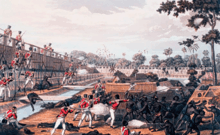 The storming of one of the principal stockades, near Yangon (Rangoon), 8 July 1824 |
|
|
British victory
|
| Lao rebellion (1826–1828) Location: Khorat Plateau, Thailand; Central and Southern Laos |
Military support: |
Siamese victory | |
| Siamese–Vietnamese War (1831–1834) Location: Cambodia, Southern Vietnam 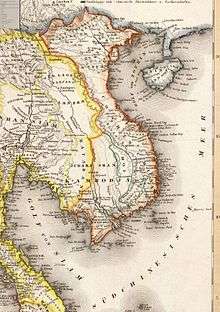 |
Vietnamese victory | ||
| Lê Văn Khôi revolt (1833–1835) Location: Southern Vietnam 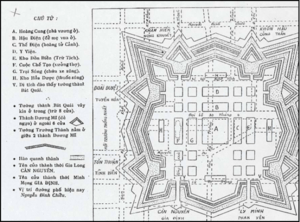 The French-built Citadel of Saigon was taken over by the rebels on 18 May 1833 and held more than two years until September 1835. |
Lê Văn Khôi rebels Supported by: |
Decisive Nguyễn dynasty victory | |
| Siamese–Vietnamese War (1841–1845) Location: Cambodia, Southern Vietnam  A map showing the movement of Vietnamese troops (from June to December 1845) in Vietnam-Siamese War (1841–1845). |
Stalemate
| ||
| Burmese–Siamese War (1849–1855) Location: Kengtung, Trans-Salween region 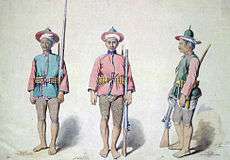 A watercolor of 3 Burmese infantry soldiers in 1855. It was not until soldiers like this were dispatched to combat the Siamese invasion that Siam was finally driven out of Burma. |
Burmese defensive victory | ||
| Haw wars (1865–1890) Location: Northern Laos, western Vietnam, northern Thailand .jpg) A Siamese army during Haw wars in 1865 |
Siamese victory | ||
| Franco-Siamese War (1893) Location: French Indochina, Siam 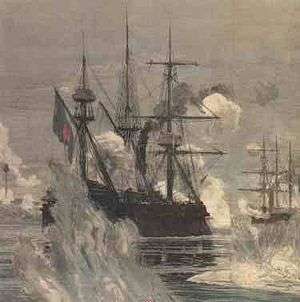 French ships Inconstant and Comète under fire in the Paknam incident, 13 July 1893 |
French victory; Entente Cordiale | ||
| World War I (1917-1918) Location: Europe  (Clockwise from the top)
|
Allied Powers:
|
Central Powers: | Allied victory
|
After 1932 revolution
| Conflict | Combatant 1 | Combatant 2 | Results |
|---|---|---|---|
| Boworadet rebellion (1933) Location: Central Thailand, Bangkok and Ratchaburi  Siamese soldiers during the rebellion |
Revolutionary Siamese Government (Khana Ratsadon) | Prince Boworadet and other royalists and his allies | Decisive win for the Siamese Government |
| Franco-Thai War (1940-1941) Location: French Indochina .jpg) French Indochina |
Indecisive
| ||
| World War II (1942-1945) Location: Southeast Asia (clockwise from top left)
|
Axis Powers: | Allied Powers: | Allied victory
|
| Malayan Emergency (1948-1960) Location: Malay Peninsula, Southeast Asia 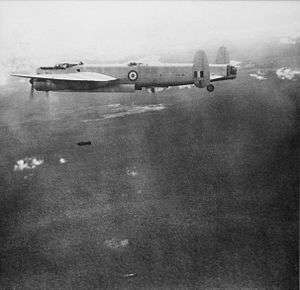 Australian Avro Lincoln bomber dropping 500lb bombs on communist rebels in the Malayan jungle (c. 1950) |
Commonwealth forces:
|
Communist forces:
Supported by: |
British/Commonwealth victory |
| Chinese Civil War (1949-1961) Location: Mainland China (including Hainan) and its coast, China–Burma border FClockwise from the top: Communist troops at the Battle of Siping; Muslim soldiers of the NRA; Mao Zedong in the 1930s; Chiang Kai-shek inspecting soldiers; CCP general Su Yu investigating the troops shortly before the Menglianggu Campaign |
|
Chinese Communist Party victory
| |
| Korean War (1950-1955) Location: Korean Peninsula, Yellow Sea, Sea of Japan, Korea Strait, China–North Korea border  Clockwise from top: A column of the U.S. 1st Marine Division's infantry and armor moves through Chinese lines during their breakout from the Chosin Reservoir • UN landing at Incheon harbor, starting point of the Battle of Incheon • Korean refugees in front of a U.S. M46 Patton tank • U.S. Marines, led by First Lieutenant Baldomero Lopez, landing at Incheon • F-86 Sabre fighter aircraft |
Medical support
|
Military stalemate
| |
| Vietnam War (1955-1975) Location: South Vietnam, North Vietnam, Cambodia, Laos, South China Sea, Gulf of Thailand 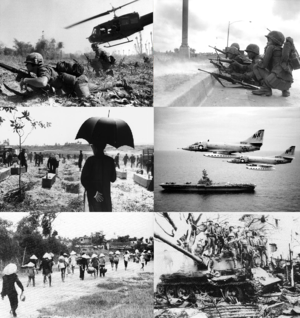 Clockwise, from top left: U.S. combat operations in Ia Đrăng, ARVN Rangers defending Saigon during the 1968 Tết Offensive, two A-4C Skyhawks after the Gulf of Tonkin incident, ARVN recapture Quảng Trị during the 1972 Easter Offensive, civilians fleeing the 1972 Battle of Quảng Trị, and burial of 300 victims of the 1968 Huế Massacre. |
|
Supported by:
|
North Vietnamese and National Liberation Front victory
|
| Laotian Civil War (1959-1975) Location: Kingdom of Laos 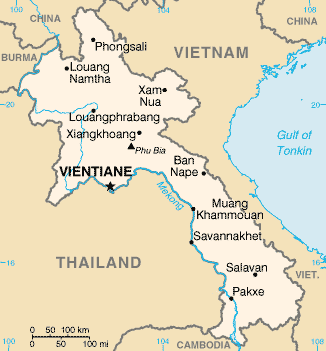 Laos |
Forces Armées Neutralistes (from 1962) Supported by:
|
Forces Armées Neutralistes (1960–1962) Patriotic Neutralists (from 1963) Supported by:
|
Pathet Lao and North Vietnamese victory
|
| Communist insurgency in Thailand (1959-1975) Location: Thailand (primarily northeast Thailand) 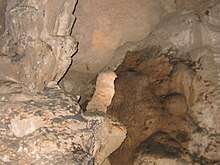 Ta Ko Bi Cave, a former hideout used by communist rebels. |
|
|
Thai government victory
|
| Cambodian Civil War (1968-1975) Location: Cambodia .jpg) US tanks entering a town in Cambodia in 1970. |
(1967–1970) (1970–1975) |
Other support:
|
Khmer Rouge victory
|
| Communist insurgency in Malaysia (1968-1989) Location: Malaysian Peninsular and Sarawak Sarawak Rangers (present-day part of the Malaysian Rangers) consisting of Ibans leap from a Royal Australian Air Force Bell UH-1 Iroquois helicopter to guard the Malay–Thai border from potential Communist attacks in 1965, two years before the war starting in 1968. |
Anti-communist forces: Supported by: |
Communist forces:
|
Peace agreement reached
|
| Third Indochina War (1975-1991) |
|
Supported by: |
|
| Vietnamese border raids in Thailand (1979–1989) Location: Thai–Cambodian border, Gulf of Thailand |
Supported by: |
Supported by: |
|
| Thai–Laotian Border War (1987-1988) Location: Chat Trakan District, Phitsanulok Province, Thailand  Sarawak Rangers (present-day part of the Malaysian Rangers) consisting of Ibans leap from a Royal Australian Air Force Bell UH-1 Iroquois helicopter to guard the Malay–Thai border from potential Communist attacks in 1965, two years before the war starting in 1968Noen 1428 (Hill 1428), the battlefield of Thai–Laotian Border War of 1988, view from Phu Soidao National Park, Chat Trakan, Phitsanulok. |
Peace talks in Bangkok
| ||
| Persian Gulf War (1990-1991) Location: Iraq, Kuwait, Saudi Arabia and the Persian Gulf 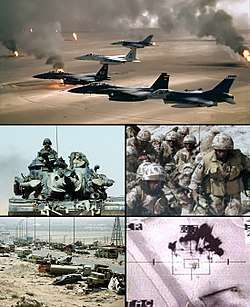 Clockwise from top: USAF F-15Es, F-16s, and a F-15C flying over burning Kuwaiti oil wells; British troops from the Staffordshire Regiment in Operation Granby; camera view from a Lockheed AC-130; the Highway of Death; M728 Combat Engineer Vehicle. |
|
Coalition victory
| |
| International Force East Timor (1999-2000) Location: East Timor  Australian members of International Force East Timor (INTERFET), talk to a citizen in Dili, East Timor, in February 2000. |
International Force: | Insurgents:
|
Conflict ended
|
| Operation Enduring Freedom – Horn of Africa (2002-present) Location: Horn of Africa, Gulf of Aden, Guardafui Channel 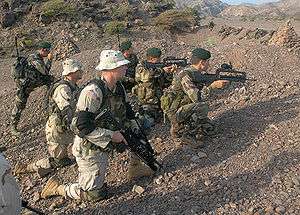 French Naval commandos (green) and United States soldiers from the 3rd Infantry Regiment (tan) participate in an exercise at Djibouti in June 2004. |
CJTF-HOA allies: Non-NATO allies: |
Insurgents:
Pirates: |
Ongoing
|
- Iraq War (2003–2004): See Thailand in the Iraq War. - Thai Humanitarian Assistance Task Force 976 Thai-Iraq Thailand deployed a 423-strong humanitarian contingent as part of the Multi-National Force – Iraq
- Operation Enduring Freedom – Horn of Africa (2002 – present) – Rpyal Thai Navy SEALs have deployed on Royal Thai Navy warships for anti-piracy operations in the Gulf of Aden off the coast of Somalia as part of Combined Task Force 151.[52][53]
- Anti-Piracy operation in Gulf of Aden
- Anti-Piracy in strait of Malacca
- Southern Insurgency
- United Nations peacekeeping
- United Nations Iraq–Kuwait Observation Mission: see Persian Gulf War (1990-1991)
- United Nations Guards Contingent in Iraq: see Persian Gulf War (1990-1991)
- United Nations Transitional Authority in Cambodia: see Vietnamese Occupation of Cambodia (1992-1993)
- United Nations Observer Mission in Sierra Leone: see Sierra Leone Civil War (1998-1999)
- United Nations Transitional Administration in East Timor: see International Force East Timor (1999-2001
- United Nations Operation in Burundi: see Burundian Civil War (2004-2007)
- United Nations–African Union Mission in Darfur
- United Nations Assistance Mission in Afghanistan: see War in Afghanistan(2012)
- United Nations Mission in Sudan: see Second Sudanese Civil War (2005-2011)
- Cambodian–Thai border stand-off
See also
Notes
- On 9 July 1951 troop constituents were: US: 70.4%, ROK: 23.3% other UNC: 6.3%[13]
References
- Jumsai 1976, p. 54.
- Jumsai 1976, pp. 54–57.
- Jumsai 1976, pp. 58–61.
- Kohn, p. 447.
- Dupuy, p. 768.
- John W. Garver (1 December 2015). China's Quest: The History of the Foreign Relations of the People's Republic of China. Oxford University Press. pp. 219–. ISBN 978-0-19-026106-1.
- A. Dahana (2002). "China Role's in Indonesia's "Crush Malaysia" Campaign". Universitas Indonesia. Archived from the original on 19 July 2016. Retrieved 19 July 2016.
- Mohd. Noor Mat Yazid (2013). "Malaysia-Indonesia Relations Before and After 1965: Impact on Bilateral and Regional Stability" (PDF). Programme of International Relations, School of Social Sciences, Universiti Malaysia Sabah. Archived from the original (PDF) on 19 July 2016. Retrieved 19 July 2016.
- Ching Fatt Yong (1997). The origins of Malayan communism. South Seas Society. ISBN 978-9971-936-12-9.
- T. N. Harper; Timothy Norman Harper (9 April 2001). The End of Empire and the Making of Malaya. Cambridge University Press. ISBN 978-0-521-00465-7.
- Major James M. Kimbrough IV (6 November 2015). Disengaging From Insurgencies: Insights From History And Implications For Afghanistan. Pickle Partners Publishing. pp. 88–. ISBN 978-1-78625-345-3.
- Geoffrey Jukes (1 January 1973). The Soviet Union in Asia. University of California Press. pp. 302–. ISBN 978-0-520-02393-2.
- Kim, Heesu (1996). Anglo-American Relations and the Attempts to Settle the Korean Question 1953–1960 (PDF) (Thesis). London School of Economics and Political Science. p. 213. Archived (PDF) from the original on 10 April 2017. Retrieved 9 April 2017.
- Young, Sam Ma (2010). "Israel's Role in the UN during the Korean War" (PDF). Israel Journal of Foreign Affairs. 4 (3): 81–89. doi:10.1080/23739770.2010.11446616. Archived from the original (PDF) on 24 August 2015.
- "Post-War Warriors: Japanese Combatants in the Korean War−− | The Asia-Pacific Journal: Japan Focus". apjjf.org.
- Edles, Laura Desfor (1998). Symbol and Ritual in the New Spain: the transition to democracy after Franco. Cambridge, UK: Cambridge University Press. p. 32. ISBN 978-0521628853.
- Edwards, Paul M. (2006). Korean War Almanac. Almanacs of American wars. New York: Infobase Publishing. p. 528. ISBN 978-0816074679. Archived from the original on 4 July 2017.
- Kocsis, Piroska (2005). "Magyar orvosok Koreában (1950–1957)" [Hungarian physicians in Korea (1950–1957)]. ArchivNet: XX. századi történeti források (in Hungarian). Budapest: Magyar Országos Levéltár. Archived from the original on 10 May 2017. Retrieved 22 November 2016.
- "Romania's "Fraternal Support" to North Korea during the Korean War, 1950–1953". Wilson Centre. December 2011. Archived from the original on 21 February 2013. Retrieved 24 January 2013.
- Stueck 1995, p. 196.
- Millett, Allan Reed, ed. (2001). The Korean War, Volume 3. Korea Institute of Military History. U of Nebraska Press. p. 541. ISBN 978-0803277960. Archived from the original on 4 July 2017. Retrieved 18 September 2015.
India could not be considered neutral.
- Birtle, Andrew J. (2000). The Korean War: Years of Stalemate. U.S. Army Center of Military History. p. 34. Archived from the original on 14 December 2007. Retrieved 14 December 2007.
- Weil, Thomas E. et. al. Area Handbook for Brazil (1975), p. 293
- "Chapter Three: 1957–1969 Early Relations between Malaysia and Vietnam" (PDF). University of Malaya Student Repository. p. 72. Retrieved 17 October 2015.
- Tunku Abdul Rahman Putra Al-Haj (Profiles of Malaysia's Foreign Ministers) (PDF). Institute of Diplomacy and Foreign Relations (IDFR), Ministry of Foreign Affairs (Malaysia). 2008. p. 31. ISBN 978-9832220268. Archived from the original (PDF) on 16 October 2015. Retrieved 17 October 2015.
The Tunku had been personally responsible for Malaya's partisan support of the South Vietnamese regime in its fight against the Vietcong and, in reply to a Parliamentary question on 6 February 1962, he had listed all the used weapons and equipment of the Royal Malaya Police given to Saigon. These included a total of 45,707 single-barrel shotguns, 611 armoured cars and smaller numbers of carbines and pistols. Writing in 1975, he revealed that "we had clandestinely been giving 'aid' to Vietnam since early 1958. Published American archival sources now reveal that the actual Malaysian contributions to the war effort in Vietnam included the following: "over 5,000 Vietnamese officers trained in Malaysia; training of 150 U.S. soldiers in handling Tracker Dogs; a rather impressive list of military equipment and weapons given to Viet-Nam after the end of the Malaysian insurgency (for example, 641 armored personnel carriers, 56,000 shotguns); and a creditable amount of civil assistance (transportation equipment, cholera vaccine, and flood relief)". It is undeniable that the Government's policy of supporting the South Vietnamese regime with arms, equipment and training was regarded by some quarters, especially the Opposition parties, as a form of interfering in the internal affairs of that country and the Tunku's valiant efforts to defend it were not convincing enough, from a purely foreign policy standpoint.
- "Why did Sweden support the Viet Cong?". HistoryNet. 25 July 2013. Retrieved 20 July 2016.
- "Sweden announces support to Viet Cong". HISTORY.com. Retrieved 20 July 2016.
In Sweden, Foreign Minister Torsten Nilsson reveals that Sweden has been providing assistance to the Viet Cong, including some $550,000 worth of medical supplies. Similar Swedish aid was to go to Cambodian and Laotian civilians affected by the Indochinese fighting. This support was primarily humanitarian in nature and included no military aid.
- Wassana Nanuam (August 2015). "Engagement of Malaysia and Indonesia on Counter Insurgency in the South of Thailand" (PDF). Asia Pacific Center for Security Studies. Archived (PDF) from the original on 29 September 2015. Retrieved 29 September 2015.
- Nazar bin Talib, pp.16–22
- Chin Peng, pp.479–80
- NIE report
- A Navaratnam, p. 10
- A. Navaratnam, p.10
- A. Navaratnam, pp.3–5
- Leszek Buszynski (13 September 2013). Soviet Foreign Policy and Southeast Asia (Routledge Revivals). Routledge. pp. 78–. ISBN 978-1-134-48085-2.
- John W. Garver (1 December 2015). China's Quest: The History of the Foreign Relations of the People's Republic of China. Oxford University Press. pp. 219–. ISBN 978-0-19-026106-1.
- A. Navaratnam, pp.189–90"
- Chin Peng, pp.189–99
- Spencer C. Tucker, Encyclopedia of the Vietnam War: A Political, Social, and Military History, p.155
- since 1982, the KR, the KPNLF and the ANS formed the Coalition Government of Democratic Kampuchea.
- "Diplomats Recall Cambodia After the Khmer Rouge - The Cambodia Daily". The Cambodia Daily. 5 April 2003. Retrieved 29 June 2018.
- Weiss, Thomas G.; Evans, Gareth J.; Hubert, Don; Sahnoun, Mohamed (2001). The Responsibility to Protect: Report of the International Commission on Intervention and State Sovereignty. International Development Research Centre (Canada). p. 58. ISBN 9780889369634. Retrieved 29 June 2018.
- https://www.rbth.com/arts/2016/03/19/when-moscow-helped-topple-the-khmer-rouge_576789
- "Den 1. Golfkrig". Forsvaret.dk. 24 September 2010. Archived from the original on 12 January 2011. Retrieved 1 February 2011.
- Pike, John. "Pirates". Global security. Retrieved 20 April 2011.
- "Eritrea 'arming' Somali militia". BBC News. 27 July 2007. Retrieved 20 May 2010.
- "UN probes Eritrea arms in Somalia – Africa". Al Jazeera English. 16 May 2009. Retrieved 20 April 2011.
- Gettleman, Jeffrey (27 July 2007). "A U.N. Report on Somalia Accuses Eritrea of Adding to the Chaos". The New York Times. Retrieved 20 May 2010.
- "Somalia Leaders Killed". New America Foundation. 740 15th Street, N.W., Suite 900, Washington, DC 20005. May 19, 2016.
- "Royal Thai Navy Anti-Piracy Fleet" (Press release). Royal Thai Embassy in Singapore. 15 July 2011. Retrieved 22 July 2018.
- Panrak, Patcharapol (8 July 2011). "Thai navy returns to Somalia for 2nd anti-piracy tour". Pattaya Mail. Retrieved 22 July 2018.
